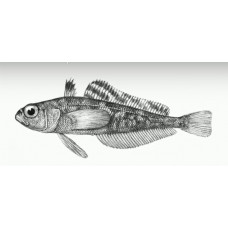Latin name
Pseudotrematomus eulepidotus
Other names
No information
Identification
First dorsal fin with 6-7 flexible barb rays, second dorsal fin with 36-38 articulated rays, anal fin with 34-36 articulated rays, pectoral fin with 27-29 rays; gill rays 6; total number of stamens in outer row of first gill arch 21-26, of which 13-16 in lower part, 7-10 gill stamens in upper part; transverse rows of scales on the body 68-75; number of tubular scales in the dorsal lateral line 42-48, in the medial lateral line 11-21 tubular scales; total number of vertebrae 54-57, of which trunk 17-20 and caudal 37. The entire body, including the head, is covered mainly with ctenoid scales. The head is very densely and completely scaled, including the occiput and interorbital space, the lateral preorbital region, the snout to the upper lip, the lower jaw and posterior part of the upper jaw, the gill space, the gill membrane and the bases of the gill rays. The body is elongated, laterally compressed and low; its height is about 18-25% of the standard body length. The head is moderately long, about 28-30% of the standard length. The mouth is terminal, with an oblique slit. The upper jaw is retractable, relatively large and 37-42% of the length of the head. The eye is large, 28-35% of the length of the head. The interorbital space is moderately wide, 20-25% of head length. Caudal fin is truncate or slightly rounded. The overall colouration of the live fish is dark yellow or pale brown, with dark spots (or short transverse stripes) on the sides, arranged in a staggered pattern. The occiput, snout and sometimes the interorbital space are dark. The upper part of the first dorsal fin is black, the second dorsal fin has dark oblique stripes, and the other fins are dark.
Distribution
It is distributed on the shelf and upper bathyal (near the shelf edge) in the Antarctic marginal seas, around the Antarctic Peninsula and also near the South Shetland and South Orkney Islands. It lives in a relatively small depth range from 80 to 550 m both on the bottom and in the water column, including near the surface.
Habitat
A bottom dwelling, largely benthic pelagic species, living at the surface and periodically ascending to the pelagic zone in search of food, mainly Antarctic krill (Euphausia superba). The change from the pelagic juvenile stage to a predominantly bottom-dwelling lifestyle probably begins when the fish reach a standard length of about 60-70mm.
Size
Medium-sized fish, reaching a standard length of 36 cm (approximately 40 cm total length) and a weight of 700 g.
Life history and Behavior
Spawning occurs in late summer to early autumn.
Food and feeding habits
It feeds mainly on small pelagic and benthic zooplankton, Antarctic krill and to a lesser extent on small fish (juveniles) and benthos. When krill aggregations are present in the habitat, it prefers to feed on them, adhering to the water column within the aggregation. Polychaetes are typical bottom-dwelling organisms found in fish stomachs. Of the zooplankton living in the bottom layer and water column, amphipods, free-living copepoda, Chaetognatha and pteropoda are the most common and Antarctic krill.
Reproduction
Sexual maturity (gonad developmental stages II-III and III) occurs at a total length of approximately 18-23 cm and a weight of approximately 80-146 g. Pre-spawning females have been recorded at a total length of 25.5 cm and a weight of 270 g. Three females with a total length of 25.6-30.5 cm and a weight of 270-510 g caught in the Mawson Sea from early March to early April 1983 had an absolute fecundity of 5907-9887 eggs and a relative fecundity of 18.4-21.9 eggs. In females close to spawning, the gonadosomatic index (ratio of ovarian weight to body weight) was 31.1% and egg diameter was 3.0-3.3 mm. The diameter of oocytes of trophoplasmic growth of the younger generation developing for next year's spawning is 0.5-0.85 mm. Gonadosomatic indices of spawning males reach 0.3-1.6%. The incubation period lasts 5-6 months according to observations in the aquarium. The larvae hatch after artificial incubation at a standard length of about 18-19 mm. In December and February, post-larvae with standard lengths of 26 mm and 38 mm were recorded in the Weddell Sea and Scotia Sea, respectively, and in March, pelagic juveniles with lengths of 32.3-40.8 mm were recorded off the Antarctic Peninsula.
| Classification | |
| Phylum | Chordata |
| Class | Actinopterygii |
| Squad | Perciformes |
| Family | Nototheniidae |
| Genus | Pseudotrematomus |
| Species | P. eulepidotus |
| Features | |
| Conservation status | No information |
| Habitat | Pelagic |
| Life span, years | No information |
| Maximum body weight, kg | 0,7 |
| Maximum length, cm | 40 |
| Sailing speed, m/s | No information |
| Threat to people | Edible |
| Way of eating | Not predator |

